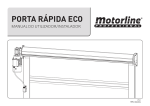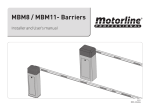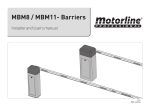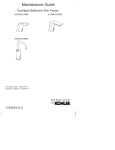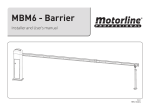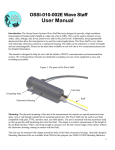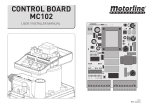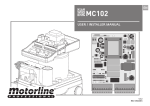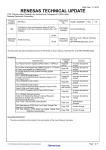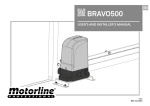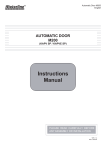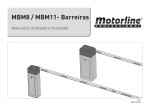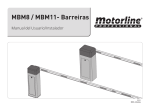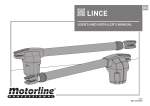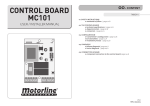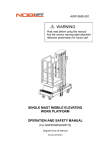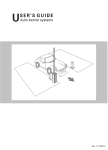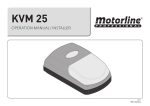Download Porta Rápida ECO - EN
Transcript
ECO FAST DOOR USER’S AND INSTALLER’S MANUAL v1.0 REV. 05/2014 00. CONTENT 01. SAFETY INSTRUCTIONS ▷ INDEX STANDARDS TO FOLLOW ◁ 00. CONTENT ▷ index | pag 01.A ATTENTION: ▷ To ensure the safety of people, it is important that you read all the following instructions.Incorrect installation or incorrect use of the product can cause physical injury and material damage. ▷ Keep these instructions in a safe place for future reference. ▷ This product was designed and produced strictly for the use indicated in this manual. Any other use, not expressly indicated here, could compromise the good condition/operation of the product and/or be a source of danger. ▷ ELECTROCELOS SA is not responsible for the improper use of the product, or other use than that for which it was designed. ▷ ELECTROCELOS SA is not responsible if safety standards were not taken into account when installing the equipment, or for any deformation that may occur to it. ▷ ELECTROCELOS SA is not responsible for the safety and proper operation when using components not sold by them. ▷ Do not make any modifications to the operator components and / or their accessories. ▷ Beffore installation unplug the automatism from the source of power. ▷ The installer must inform the client how to handle the product in case of emergency and provide this manual to user. ▷ Keep remote controls away from children, to prevent the automated system from being activated involuntarily. ▷ The customer shall not, under any circumstances, attempt to repair or tune the operator .Must call qualified technician only. ▷ Connect the automatism to a 230V plug with ground wire. ▷ Automatism for indoor use only. 01. SAFETY INSTRUTIONS ▷ standards to follow | pag 01.B 02. THE PACKAGE ▷ inside the package | pag 02.A 03. THE AUTOMATISM ▷ technical specifications | pag 02.B 04. INSTALLATION ▷ pre-installation info | pag 03.B ▷ manual opening/closing | pag 03.B ▷ safe profile fixation | pag 04.A ▷ lateral guides fixation | pag 05.A ▷ control board fixation | pag 06.A ▷ limit-switches adjustment | pag 06.B ▷ installation map | pag 07.A 05. MC15 CONTROL BOARD CONFIG ▷ limit-switches verification | pag 08.A ▷ door’s course programming | pag 08.B ▷ pause time configuration | pag 09.A ▷ potentiometers | pag 09.A ▷ transmitters configuration | pag 09.B 06. TROUBLESHOOTING ▷ instructions for final consumers | pag 10.A ▷ instructions for installers | pag 10.A 07. CONTROL BOARD CONNECTIONS ▷ central MC15 motorline | pag 11.A 01.A 01.B 02. PACKAGE 03. AUTOMATISM ▷ INSIDE PACKAGE TECHNICAL SPECIFICATIONS ◁ ▷ Power supply ▷ 01 Motor ▷ 02 Lateral Guides ▷ 01 Safe aluminum profile ▷ 01 Tarpaulin ▷ 01 Control board ▷ 01 Photocells Set MF101 ▷ 01 Exterior Push Button ▷ 01 Metal Plates for Guides FIxation ▷ 01 User’s Manual ▷ Power 250W ▷ Current 1,92A MOTOR Inside the package you will find the following components: Tarpaulin Lateral Guides Metal Plates for Guides Fixation <60dB ▷ Torque 18,1Nm ▷ Working temperature ▷ Protection level TARPAULIN Fixation Screws IP55 Intensive Class F 16µ ▷ Starting up capacitator 20µ ▷ Power supply 230V 50/60Hz ▷ Working temperature -40°C to 65°C ▷ Protection level ▷ Working frequency IP55 Intensive ▷ Courtesy light output 230V 100W ▷ RGB LEDs output 24V 100mA ▷ Maximum power output for motor ▷ Acessory power supply output ▷ Dimensions ▷ Weight ▷ Tensile strength ▷ Tear strength ▷ Adhesion ▷ Finish ▷ Working temperatures 02.A -30°C to 70°C ▷ Working capacitator ▷ Wire Control Board User ‘s Manual 132RPM ▷ Noise level ▷ Isolation class CONTROL BOARD MC15 Motor ▷ RPM ▷ Working frequency Safe Aluminum Profile 230V 50/60Hz 750W 24V 6W 108x138mm 1100 dtex PES HT 670g/m² 2800N/5cm 300N 90N/5cm Varnished both sides -30°C to 70°C 02.B 03. AUTOMATISM 04. AUTOMATISM ▷ TECHNICAL SPECIFICATIONS PRE-INSTALLATION INFO ◁ For a proper ECO FAST DOOR function, check the following parameters before installing the automatismo: ▷ Read all steps at least once in order to get familiar with the installation and configuration process. 165mm ▷ Check the horizontal alignment of the ground so that the door can be correctly assembled. 27mm 250mm 160mm máx: 3200mm ▷ Make sure there is an adequate protection against electrical shorts / current peaks and ground wire connection in Electrical Box. 35mm ▷ Be careful handling directly the control board. Improper handling can damage some electrical components and even cause damage to the user. ▷ Make sure you have all the necessary materials prepared for installation. 215mm 410mm Width Door’s free space max:3000mm 40mm MANUAL OPENING/CLOSING ◁ To open or close the door manually, simply pull and hold down the unlock lever in the shaded image and use a 6mm hexagon wrench to rotate the screw installed in the bottom of the engine, as shown on the image. 100mm ▷ Rotating to the right will open the door and Rotating to the left will close it. 148mm 205mm ▷ Evaluate the safety devices to be installed. This will ensure that unexpected accidents do not happen. 115mm To facilitate the task use an automatic screw machine, in order to rapidly rotate the screw. 252mm - For every 10 turns, the door will go up / down about 250mm. It is very important that all precautions are respected! Only in this way the correct functioning and durability of automatism can be achieved! 133mm 03.A 03.B 04. INSTALLATION 04. INSTALLATION ▷ SAFE PROFILE FIXATION SAFE PROFILE FIXATION ◁ (FREE DOOR SPACE) 85mm A B D C E 1▷ Apply the safe aluminum profile in the wall’s installation location as shown in (A), taking into account the horizontal position and the measures indicated in (B). The safe should also be centered with the door’s free space. 2▷ Make holes at the marked locations, and then apply the safe profile on the wall and secure with expansion bolts and screws - scheme (D). The safe must be firmly fixed so that accidents do not occur. Based on existing holes in the support plates, mark the locations for drilling - scheme (C). In the scheme (E) is visible the safe already properly tightened. 04.A 04.B 04. INSTALLATION 04. INSTALLATION ▷ LATERAL GUIDES FIXATION LATERAL GUIDES FIXATION ◁ 4▷ Attach the lateral guides on the support plates with screw, tightening them in the nuts located on the guides. I F G 3▷ Unlock the motor pulling the lever down (see page 06.A 05 ) and manually pull the tarpaulin down for about 500mm as visible in (F). J 5▷ Fix the lateral guides to the ground using the existing plates. Start by making the holes in the ground using the existing holes on plates for the application of screws. Finally, fasten the screws until the guide is properly secure. Now apply the lateral guides, by placing them at the inner side of the support plates and against the wall (G). The tarpaulin should be inside the guides (H), so that it can move up and down always within guides. H 05.A 05.B 04. INSTALLATION 04. INSTALLATION ▷ CONTROL BOARD FIXATION LIMIT-SWICHES ADJUSTMENT ◁ 195mm EXPANSION BOLTS SCREWS Y 174mm A ▷ Closing limit-switch ▷ Turn clockwise to increase course ▷ Rotate counterclockwise to decrease course A B ▷ Opening limit-switch ▷ Turn clockwise to increase course ▷ Rotate counterclockwise to decrease course B 1▷Taking into account the indicated measures, determine the drilling location. 2▷ Make the drilling in the wall. 3▷ Fix the control board case on the wall. Must use screws with expansion bolts (screws and expansion bolts not provided in this kit). Region’s detail (Y) 06.A NOTE ▷ The limit-switches will already be adjusted from factory to the door dimensions. 06.B 04. INSTALLATION ▷ INSTALLATION MAP 01 02 01 06 03 07 05 02 B A C 08 04 1 04 11 2 D 13 09 12 LEGEND: 01 ▷ Aluminum safe profile 02 ▷ Safe profile’s support plate 03 ▷ Motor 04 ▷ Lateral guides 05 ▷ Motor unlock lever 06 ▷ Limit-switches support 07 ▷ Limit-switches 04 3 10 08 ▷ Tarpaulin 09 ▷ Control board 10 ▷ Guides fixing metal plates to ground 11 ▷ Conection Plug 12 ▷ Photocells 13 ▷ Photocells support plate 4 07.A 05.MC15 CONTROL BOARD CONFIG 05. MC15 CONTROL BOARD CONFIG ▷ LIMIT-SWITCHES VERIFICATION DOOR’S COURSE PROGRAMMING ◁ The first step in programming the control board is to check all the connections from the multiple devices to the control board. Check the wiring (pag.11 A). The LEDs BL e DS must be both ON so that the door can work properly. If they are not, check the connections of the security devices. In case you don’t use any security device, please close all circuits with shunts. You must start the configuration with both potentiometers at middle adjustment. The final adjustment will be made after programming the door’s course. Open: - The LED FAP must turn off and the LED FCH must remain on. ▶ Programming the door’s course: 1▷ Unlock the motor pulling the lever down (pag. 07.A 05 ). 2▷ Push the tarpaulin manually untill middle course and release the lever to lock the motor. 3▷ Press the SEL key and the LED CODE will start to blink. Press again the SEL key as many times as you need until the LED PGM AUTO starts blinking. 4▷ Press and hold SET key and the door must start to close! Middle Course: - The LEDs FAP and FCH must remain on. Closed: - The LED FCH must turn off the LED FAP must remain on. After checking the connections, make sure the limit switches are working properly. ▶ Check the Limit-Switches: 1▷Unlock the motor pulling the unlock lever (pag 07.A 05 ) and manually pull the door to the middle course (pag 03.B). 2▷ Check if the LEDs FCH and FAP are on. If not, check if the connections are properly made. 3▷ Manually close the door and FCH LED must turn off. 4▷ Manually open the door and FAP LED must turn on. If LEDs do not go off as explained, it means that the limit switches cables are not well connected. Switch the wires from terminals 7 and 9 of CN3 connector. WARNING: If the door starts opening, release the SET key, switch the cables of the terminals 5 and 7 of CN2 connector and restart this programming. 5▷ Let the door close, open and close once again automatically, always keeping the SET key pressed. 6▷ Once the door finishes closing for the second time, the LED PGM AUTO will stay ON permanently and the LED T.MOTOR will start to blink. Release SET key and wait 10seconds until the LED T.MOTOR stops from blinking. 7▷ The programming is now complete and you can use the door normally. PGM AUTO SET SEL The whole process of programming the limit-switches must be performed with the control board connected to a 230V power source. 08.A 08.B 05. MC15 CONTROL BOARD CONFIG 05. MC15 CONTROL BOARD CONFIG ▷ PAUSE TIME CONFIGURATION TRANSMITTERS CONFIGURATION ◁ The pause time is the time that the door stays paused since it completes the opening maneuver until it starts to close automatically. ▶ Programming the pause time in automatic mode: 1▷ Press the SEL key one time and the LED CODE will start blinking. Press again the SEL key as many times as you need until the LED T.PAUSA starts blinking. 2▷ Press SET one time and wait as much time as you want for pause time. 3▷ Press SET one time after waiting the desired time and the pause time is defined. ▶ Programming transmitters: 1▷ Press one time the SEL key and the LED CODE will start blinking. 2▷ Press one time the transmitter key you want to operate the door. 3▷ When pressing the transmitter key, the LED CODE must turn and stay ON signaling the success of the configuration. If the LED CODE doesn’t stay ON, the transmitter was not programmed. Please repeat the same steps to try once again. NOTE: To program several transmitters, repeat the same steps above for each one of the transmitters. ▶ Erase transmitters: ▷ POTENTIOMETERS 1▷ Press one time the SEL key and the LED CODE will start blinking. 2▷ Press and hold the SEL key for about 5 seconds until the CODE LED turns off, indicating the memory’s reset success. ▶ Adjust sensibility and force potentiometers: The force potentiometer controls the force of the motor when opening and closing. The sensibility potentiometer controls the sensibility of the control board when detecting obstacles. The more sensitive it is the quicker it will detect any obstacle during it’s course and invert the orientation of working of the motor. 1▷ To adjust potentiometers, run them with a small screwdriver. Turning to the right side, will increase and turn to the left will decrease. NOTE: Everytime you make an adjustment to the force potentiometer, you must perform a new door’s course configuration (see page 08.B). T.PAUSA CODE SET SEL Sensibility Force 09.A 09.B 06. TROUBLESHOOTING ▷ INSTRUCTIONS FOR FINAL USERS Anomaly Procedure Behavior INSTRUCTIONS FOR INSTALLERS ◁ Procedure II Discovering the origin of the problem ▷ Door doesn't work ▷ Make sure you have 230V power supply connected to operator and if it is working properly. ▷ Still not working ▷ Consult a qualified MOTORLINE technician. 1 ▷ Open control box and check if it has 230V power supply; 2 ▷ Check input fuses; ▷ Door doesn’t move but makes noise ▷ Unlock door and move the tarpaulin by hand to check for mechanical problems on the movement ▷ Encountered problems? ▷ Consult a qualified MOTORLINE technician. 1 ▷ Check all motion axis and associated motion systems related with the door to find out what is the problem. ▷ The tarpaulin moves easily? ▷ Consult a qualified MOTORLINE technician. 1 ▷ Check capacitors, testing operator with new capacitor; 2 ▷ If capacitors are not the problem, disconnect motor from control board and it them by ▷ Door opens but doesn’t close ▷ Unlock motor and move tarpaulin by hand to closed position. Lock motor again and turn off power supply for 5 seconds. Reconnect it and send order to open door using transmitter. ▷ Door opened but didn’t close again 1 ▷ Check if there is any obstacle in front of the photocells; 2 ▷ Check if any of the control devices (key selector, push button, video intercom, etc.) of the door are jammed and sending permanent signal to control unit; 3 ▷ Consult a qualified MOTORLINE technician. All MOTORLINE control boards have LEDs that easily allow to conclude which devices are with anomalies. All safety devices LEDs (DS) in normal situations remain On. All "START" circuits LEDs in normal situations remain Off. ▷ Unlock door and move boom by hand to check for mechanical problems on the door. ▷ Encountered problems? ▷ Consult a qualified MOTORLINE technician. 1 ▷ Check all motion axis and associated motion systems related with the door to find out what is the problem. ▷ Tarpaulin moves easily? ▷ Consult a qualified MOTORLINE technician. 1 ▷ Check capacitors, testing with new capacitors; 2 ▷ If capacitors are not the problem, disconnect motor from control board and test it by connecting directly to power supply in order to find out if it is broken; 3 ▷ If the motor doesn’t work, remove it from installation site and send to our MOTORLINE ▷ Door doesn’t make complete route 3 ▷ Disconnect door from control board and test them by connecting directly to power supply in order to find out if they have problems (see page 11.A). 4 ▷ If the door works, the problem is on the control board. Pull it out and send it to our MOTORLINE technical services for diagnosis; connecting directly to power 3 ▷ If the motor works, the supply in order to find out if it has problem is from control board. problems (see page 11.A). Pull it out and send it to our MOTORLINE technical services for diagnosis; If LEDs devices are not all On, there is some security systems malfunction (photocells, safety edges), etc. If "START" circuits LEDs are turn On, there is a control device sending permanent signal. 5▷ If the door doesn’t work, remove them from installation site and send to our MOTORLINE technical services for diagnosis. 4 ▷ If the motor doesn’t work, remove them from installation site and send to our MOTORLINE technical services for diagnosis. A) SECURITY SYSTEMS: B) START SYSTEMS: 1 ▷ Close with a shunt all safety systems on the control board (check manual of the control board in question). If the automated system starts working normally check for the problematic device. 2 ▷ Remove one shunt at a time until you find the malfunction device . 3 ▷ Replace it for a functional device and check if the motor works correctly with all the other devices. If you find another one defective, follow the same steps until you find all the problems. 1 ▷ Disconnect all wires from START terminal input (terminal 3 of CN3 connector). 2 ▷ If the LED turned Off, try reconnecting one device at a time until you find the defective device. technical services for diagnosis. 4 ▷ If motor work well and move door at full force during the entire course, the problem is from controller. Set force using trimmer on the board. Make a new working time programming , giving suffient time for opening and closing with appropriate force (page 08.B). NOTE: In case procedures described in sections A) and B) don’t result, remove control board and send to our technical services for diagnosis. 5 ▷ If this doesn’t work, remove control unit and send it to MOTORLINE technical services services. NOTE: Setting force of the controller should be sufficient to make the door open and close without stopping, but should stop and invert with a little effort from a person. In case of safety systems failure, the door shall never cause physical damaged to obstacles (vehicles, people, etc.). 10.A 2 3 4 F N 230V FREIO 230V 1 7 Wire nº3 Wire nº2 Wire nº1 Wire nº5 Z1 V1 U1 ~ ~ STOP button ~ ~ DV 12/24V COM NC Photocells Black White Grey White Yellow Yellow Red Red Yellow Yellow Red Red Open Common Close 2 +V ENC 1 CN5 START button FCH DS FAP 9 10 11 8 7 6 DV 12/24V Grey Permanent Capacitor 4 Yellow 16µ 5 Green PUL BL 3 FCH Brown Motor Red V 2 Black 1 DS FAP 24V Grey V2 U2 Z2 6 MOTOR 1 AP COM CH 5 LEDs OUT 3 OUT 4 Purple Earth Wire 2 F1=6,3TL250V PUL BL OUT 1 OUT 2 3 Heatsink 7812 LM 20µ A2 22 A1 12 Exterior Push Button (ou) Exterior Radar Starting Capacitor RELAY 24V Limit-Switch 21 24 11 14 Interior Radar - FORÇA + - SENS.+ RX - Recetor 1 CN3 CN4 SEL SET +12V G R B Blue Orange Green White CN2 RR1 5 4 F2=160mAL250V 3 CN9 Black Yellow Red CN1 CN8 PGM. AUT T.MOT T. MOT. P T. PAUSA 2 CODE CODE P. CMD AP. L CORT. 1 LED RGB Stripe 07. CONTROL BOARD CONNECTIONS ▷ CENTRAL MC15 MOTORLINE Black Wire nº6 11.A












